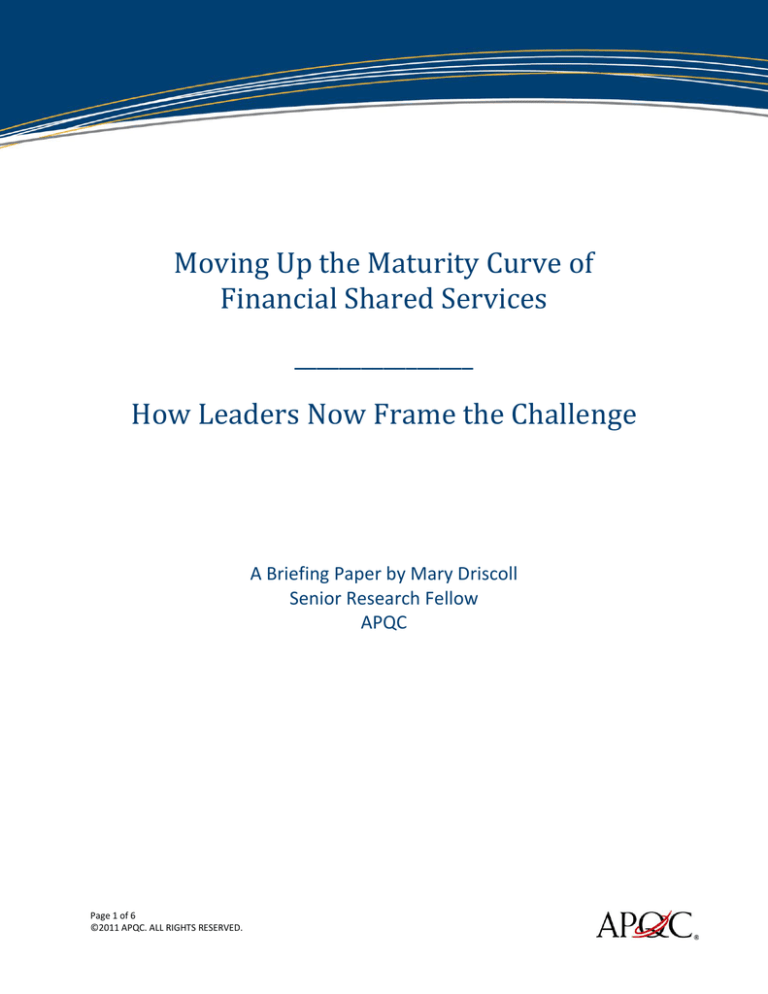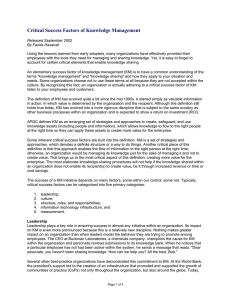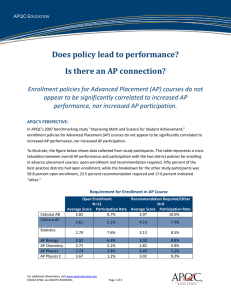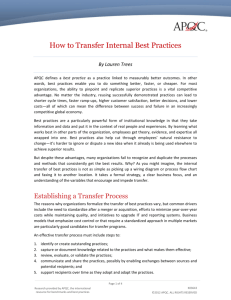
Moving Up the Maturity Curve of
Financial Shared Services
________________
How Leaders Now Frame the Challenge
A Briefing Paper by Mary Driscoll
Senior Research Fellow
APQC
Page 1 of 6
©2011 APQC. ALL RIGHTS RESERVED.
A CONSTANT HUNT FOR IMPROVEMENT
How can you tell if a financial shared services organization1 is well on its way up the maturity curve? For
a start, the leadership team looks beyond cost reduction. Surely, there is a constant hunt for costefficiency, but there is also talk of process innovation and value-adding capabilities.
A good example is Citigroup. Arindam Mukhopadhyay, the executive vice president who manages global
financial reporting operations for the sprawling financial institution, summed up this view in a speech he
gave at a conference on Finance Transformation, produced by the Shared Services Outsourcing Network
(SSON) last September. “Finance is not a department of accountants and analysts but a series of
processes that culminates in stewardship and decision making. For this reason, building a shared
services model cannot be a cost-only play.” His view is shared by other global players working to ensure
their respective shared services units can achieve productivity gains every year and develop increasingly
mature capabilities.
The leaders view process innovation as a never-ending quest, with no anticipated end to productivity
gains or expectation of diminishing returns. “My incentive compensation is tied to a 5 percent
productivity increase, every year, in perpetuity. And I’m quite happy with that,” said a senior finance
executive who runs a top-notch global business services group in an interview with APQC.
In all, the executives who manage these ever-evolving shared services centers say their roles are
becoming more strategic. They aim to:
generate and disseminate financial intelligence across their organizations in order to drive strong
decisions concerning the allocation of capital,
continuously pursue opportunities to reduce the cost of core transaction processing, and
improve internal controls and rules compliance in an era of regulation.
HOW DID WE GET HERE?
Large, global organizations have, over the past decade, made clear strides in reducing the cost of
financial management operations by adopting a shared services operating model. Figure 1 below,
sourced from APQC’s Open Standards Research, illustrates that organizations with shared services in
APQC’s accounts payable dataset have a significantly lower cost of accounts payable per $1,000
revenue.
1
The shared services model calls for streamlining and consolidating transaction-based activities, such as
invoice processing and payment or billing, in regional or global service centers.
Page 2 of 6
©2011 APQC. ALL RIGHTS RESERVED.
Total Accounts Payable Cost per $1,000 Revenue
$2.00
$1.75
$1.73
$1.50
$1.12
$1.00
$0.99
$0.78
Operating / Business Unit
N = 115
Shared Services Center
N = 101
$0.69
$0.50
Headquarters
N = 70
$0.57
$0.44
$0.24
$0.00
Top
Performers
Median
Bottom
Performers
Figure 1
Some have used the single/centralized shared services model to deliver services to business units
around the world. Others have developed hybrid models that use a centralized processing center as well
as multiple, region-oriented shared services centers. The latter approach is often chosen to allow an
organization to cope effectively with varying languages, cultures, and business practices.
In addition, some organizations have blended service delivery from so-called “captive” financial
management shared services, which are company-owned service centers, and shared services owned
and operated by a third party. Captives and third-party centers may be located on-shore, near-shore, or
offshore.
COST REDUCTION IS NOT ENOUGH
The recent recession, along with ongoing economic uncertainty worldwide, has raised burning questions
in boardrooms and C-suites.
How can we improve our ability to predict and manage the strategic risks to our business plans?
How can we deliver sustainable, profitable growth to investors when revenue growth is spotty in
first-world countries and inflation risk looms in emerging economies?
How can we do a better job of protecting profits from the growth we do manage to capture?
How well-equipped is finance to answer these questions? Concerns were raised in a white paper
prepared by CFO Research Services and in collaboration with Crowe Horwath2. Board members who
2
“Getting Beyond Good Enough: Higher Value Reporting for the Board,” a March, 2010 report prepared by CFO Research
Services in collaboration with Crowe Horwath LLP.
Page 3 of 6
©2011 APQC. ALL RIGHTS RESERVED.
were surveyed expressed the view that finance excels in its traditional scope—GAAP financial reporting
and audit review reporting—but disappoints when it comes to business analyses, especially:
operational performance reporting,
business performance forecasting,
risk assessment and related reporting, and
risk tolerance exposure reporting.
Nothing says an organization must include its financial shared services center in higher-order business
analytics. However, the findings from a recent APQC survey3 indicate that the next-generation financial
shared services center will have a seat at the table. As shown in Figure 2 below, the top five goals for
financial management shared services (in declining order of importance, with the top possible rating of
5 signalling “extremely important”) are to:
1. provide a proper mix of analytics and efficient transaction processing;
2. drive yearly productivity increases in perpetuity;
3. empower, train, and motivate people to achieve continuous improvement;
4. make the center a source of valuable decision support to the business; and
5. align financial management shared services process measures with organizational strategy.
Figure 2
THE DESIRED ANALYTICAL YIELD
One example of useful analyses that can emanate from financial management shared services involves
payment patterns of customers that make purchases from multiple operating units. The goal would be
to take a granular look at the payment behaviors of the most valuable customers, perhaps the highvolume buyers versus the least valuable. Such analyses could lead to changes in the ways trade-credit
policies are applied, with the low-value customers automatically tagged for strict policy enforcement,
perhaps involving automated work flows and alerts if bill payment patterns start to slip. The high-value
3
“Financial Shared Services—Framing Your Next Generation Capabilities,” an APQC survey conducted in September 2010.
Page 4 of 6
©2011 APQC. ALL RIGHTS RESERVED.
customers can be accommodated with personal calls by dedicated account managers to quickly resolve
any billing discrepancies or address other causes of payment deterioration, when necessary.
Processes of this sort can be optimized with automation. For example, one top performer in a study of
financial management shared services now being conducted by APQC is a leading, global manufacturer
of glass bottles. The center that manages the order-to-cash process does analyses along the lines
described above—enabled by specialized analytical software. Moreover, the team works in a continuous
improvement mode by applying Six Sigma principles and disciplines to accounts receivable and other
financial management processes related to working capital management. The result is tight control over
the amount of working capital that is tied up in accounts receivable, along with effective collaboration
with the organization’s most valuable customers.
There is no end to the types of value-adding business analytics that can be generated by a top-notch
financial management shared services center. That aspiration is held by people such as HelwettPackard’s Jeff Fiorini, who is the Manager of P2P Process Transformation. He shared his vision of internal
FM shared services process maturity at the SSON’s September conference. (Figure 3, below).
FM Process Evolution
Stage One: Cost Reduction
Decentralized
Regional SSO
Global SSO
and Processes
Stage Two: Increase Value
Tech
Enablement
Process
Optimization
Adding
Business
Value
Figure 3
Today, there is flurry of activity aimed at evolving the procure-to-pay process, especially in a shared
services environment. Common goals are: drastically reducing the volume of paper invoices,
compressing the time required to route invoices for approval and payment, increasing the volume of
“first-time PO/invoice matches,” and more robust self-service solutions to enable suppliers to access all
the information they seek without human intervention on the buyer’s part.
One compelling aspect of current process innovation: automating the validation of invoices at the front
end of the invoice management process. Computers would read digitized invoices and trigger steps that
resolve errors and obtain missing data. Conceivably, by the time most invoices arrived in accounts
payable, they would already be in perfect condition. The people in AP would work on the exception
items, not the run-of-the-mill items. By reducing touchpoints and the time spent by finance and
Page 5 of 6
©2011 APQC. ALL RIGHTS RESERVED.
accounting staff on mundane paperwork and by hastening the invoice-turnaround cycle, this
organization would truly be raising the bar for both process efficicency and effectiveness.
In sum, superior performance in the area of cost control and cycle time empowers financial
management shared services centers to move further up the curve. The mature center leverages its
people properly and provides value-adding services, including business analytics, to internal and
external business partners.
ABOUT APQC
For more than 30 years, APQC has been on the leading edge of improving performance and fostering
innovation around the world. APQC works with organizations across all industries to find practical, costeffective solutions to drive productivity and quality improvement. We are a member-based nonprofit
currently serving more than 500 organizations in all sectors of business, education, and government.
CONTACT INFORMATION
123 North Post Oak Lane, Third Floor
Houston, TX 77024-7797
phone: +1-713-681-4020 or 800-776-9676
fax: +1-713-681-8578
e-mail: apqcinfo@apqc.org
www.apqc.org
Page 6 of 6
©2011 APQC. ALL RIGHTS RESERVED.





